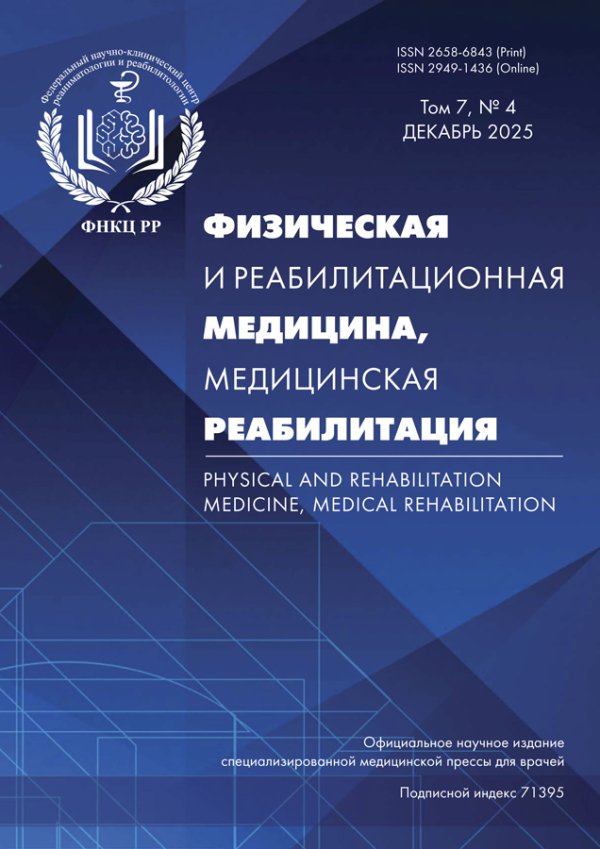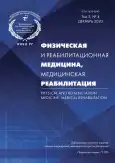Quality of models of scales of consciousness level, functional state, and general somatic severity in patients with consequences of brain damage in intensive care and rehabilitation department
- Authors: Kiryachkov Y.Y.1, Petrova M.V.1,2, Pryanikov I.V.1,2, Kolesov D.L.1, Parfenov A.L.1, Bosenko S.A.1
-
Affiliations:
- Federal Research and Clinical Center of Intensive Care Medicine and Rehabilitology
- Peoples’ Friendship University of Russia
- Issue: Vol 2, No 4 (2020)
- Pages: 303-314
- Section: ORIGINAL STUDY ARTICLE
- URL: https://journal-vniispk.ru/2658-6843/article/view/46402
- DOI: https://doi.org/10.36425/rehab46402
- ID: 46402
Cite item
Full Text
Abstract
Background. The approach to the use of scales for assessing the level of consciousness, functional and general somatic status for rehabilitation and intensive care units is statistically and clinically insufficiently substantiated.
Aims: development and substantiation of a typical scheme for the clinical use of scales of the level of consciousness, general somatic and functional status of patients with consequences of brain damage of various etiologies.
Methods. A single-center prospective, retrospective study that included 118 patients on 20–50 days after traumatic brain injury, anoxic damage; consequences of acute cerebral circulatory disorders, and neurosurgical operations. In groups of patients who are in a coma, vegetative status, a state of minimal consciousness and a state of clear consciousness, the analysis of the statistical quality of clinical scales was carried out: scales of consciousness: the Glasgow Coma Scale (GCS); FOUR (Full Outline of UnResponsiveness); Coma Recovery Scale-Revised (CRS-R); the Glasgow Outcome Scale (GOS); the Extended Scale of the Glasgow Coma (Glasgow Outcome Scale Extended, GOSE); Rancho Los Amigos scale — scale of consciousness and interaction with the environment (the Rancho Los Amigos scale, RLAS); Functional status scales: DRS (the Disability Rating Scale); modified Rankin Scale mRS; Barthel Activities of Daily Living (ADL) Index; Functional Independence Measure (FIM); Karnovsky Index; Rivermead Mobility Index self-assessment of everyday life opportunities in Merton and Sutton (checklist self-maintenance Merton and Sutton community NHS trust); Scales of General somatic severity: assessment of multi-organ dysfunction on the APACHE II scale (Acute Physiology and Chronic Health Evaluation); APACHE IV scale; SAPS II scale (Simplified Acute Physiology Score); SOFA scale (Sequential Organ Failure Assessment). The functional state of the ANS was recorded using HRV parameters by recording 5-minute RR intervals of the electrocardiogram.
Results. There are 4 groups of patients who are in a state of coma, vegetative status, a state of minimal consciousness and a state of clear consciousness. In 67 patients out of 118 examined (56.8%) after brain and brain damage as a result of TBI, anoxia, stroke, the parameters of ANS functional activity are in the zone of pathological (sympathetic/parasympathetic hyperactivity) values. Manifestations of sympathetic/parasympathetic hyperactivity is progressively reduced from the patients in a coma to patients in clear consciousness.
Conclusions. Various scales of the level of consciousness, functional and general somatic severity of patients with the consequences of brain damage, objectively differ in clinical significance in the gradation of coma–vegetative status–minimal consciousness–clear consciousness.
Full Text
##article.viewOnOriginalSite##About the authors
Yuri Y. Kiryachkov
Federal Research and Clinical Center of Intensive Care Medicine and Rehabilitology
Author for correspondence.
Email: kiryachyu@yandex.ru
ORCID iD: 0000-0001-5113-199X
SPIN-code: 2726-8833
MD, PhD
Russian Federation, 107031, Moscow, st. Petrovka, 25, building 2Marina V. Petrova
Federal Research and Clinical Center of Intensive Care Medicine and Rehabilitology; Peoples’ Friendship University of Russia
Email: mail@petrovamv.ru
ORCID iD: 0000-0003-4272-0957
SPIN-code: 9132-4190
MD, PhD, Professor
Russian Federation, 25-2, Petrovka street, Moscow,107031; 6, Miklukho-Maklaya street, Moscow, 117198Igor V. Pryanikov
Federal Research and Clinical Center of Intensive Care Medicine and Rehabilitology; Peoples’ Friendship University of Russia
Email: drpr@ya.ru
ORCID iD: 0000-0003-3792-9107
SPIN-code: 8551-2286
MD, PhD, Professor
Russian Federation, 25-2, Petrovka street, Moscow,107031; 6, Miklukho-Maklaya street, Moscow, 117198Dmitry L. Kolesov
Federal Research and Clinical Center of Intensive Care Medicine and Rehabilitology
Email: dimoz@yandex.ru
ORCID iD: 0000-0002-8450-5211
SPIN-code: 1016-1374
MD
Russian Federation, 25-2, Petrovka street, Moscow,107031Alexander L. Parfenov
Federal Research and Clinical Center of Intensive Care Medicine and Rehabilitology
Email: Alpar45r@mail.ru
ORCID iD: 0000-0002-5012-0516
SPIN-code: 5952-1959
MD, PhD
Russian Federation, 25-2, Petrovka street, Moscow,107031Sergey A. Bosenko
Federal Research and Clinical Center of Intensive Care Medicine and Rehabilitology
Email: bosenich@mail.ru
ORCID iD: 0000-0002-9447-0622
SPIN-code: 3285-5759
MD
Russian Federation, 25-2, Petrovka street, Moscow,107031References
- Zappa S, Fagoni N, Selleri C, et al. Determination of imminent brain death using the full outline of unresponsiveness score and the glasgow coma scale: a prospective, multicenter, pilot feasibility study. J Intensive Care Med. 2020;35(2):203−207. doi: 10.1177/0885066617738714.
- Salmani F, Mohammadi E, Rezvani M, Kazemnezhad A. The effects of family-centered affective stimulation on brain-injured comatose patients’ level of consciousness: a randomized controlled trial. Int J Nurs Stud. 2017; 74:44−52. doi: 10.1016/j.ijnurstu.2017.05.014.
- Majdan M, Brazinova A, Rusnak M, Leitgeb J. Outcome prediction after traumatic brain injury: Comparison of the performance of routinely used severity scores and multivariable prognostic models. J Neurosci Rural Pract. 2017;8(1):20−29. doi: 10.4103/0976-3147.193543.
- Edlow BL, Chatelle C, Spencer CA, et al. Early detection of consciousness in patients with acute severe traumatic brain injury. Brain. 2017;140(9):2399−2414. doi: 10.1093/brain/awx176.
- Feigin VL, Barker-Collo S, Krishnamurthi R, et al. Epidemiology of ischaemic stroke and traumatic brain injury. Best Pract Res Clin Anaesthesiol. 2010;24(4):485−494. doi: 10.1016/j.bpa.2010.10.006.
- Montano N, Stifano V, Skrap B, Mazzucchi E. Management of residual subdural hematoma after burr-hole evacuation. The role of fluid therapy and review of the literature. J Clin Neurosci. 2017;46:26−29. doi: 10.1016/j.jocn.2017.08.041.
- Kinoshita T, Nishimura Y, Nakamura T, et al. Effects of physiatrist and registered therapist operating acute rehabilitation (PROr) in patients with stroke. PLoS One. 2017; 12(10):e0187099. doi: 10.1371/journal.pone.0187099.
- He Q, Zhou Y, Wang F, et al. Blood type o predicts hematoma expansion in patients with intracerebral hemorrhage. J Stroke Cerebrovasc Dis. 2019;28(8):2311−2317. doi: 10.1016/j.jstrokecerebrovasdis.2019.05.022.
- Formisano R, Giustini M, Aloisi M. An International survey on diagnostic and prognostic protocols in patients with disorder of consciousness. Brain Inj. 2019:33(8):974−984. doi: 10.1080/02699052.2019.1622785.
- Mirow S, Wilson SH, Weaver LK, et al. Linear analysis of heart rate variability in post-concussive syndrome. Undersea Hyperb Med. 2016;43(5):531−547.
- Osteraas ND, Lee VH. Neurocardiology. Handb Clin Neurol. 2017;140:49−65. doi: 10.1016/B978-0-444-63600-3.00004-0.
- Esterov D, Greenwald BD. Autonomic dysfunction after mild traumatic brain injury. Brain Sci. 2017;7(8):100. doi: 10.3390/brainsci7080100.
- Hilz MJ, Wang R, Markus J, et al. Severity of traumatic brain injury correlates with long-term cardiovascular autonomic dysfunction. J Neurol. 2017;264(9):1956−1967. doi: 10.1007/s00415-017-8581-1.
Supplementary files








